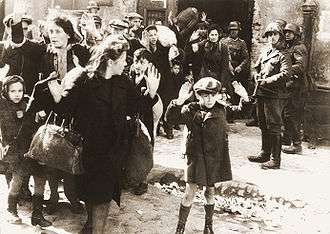Josef Blösche
| Josef Blösche | |
|---|---|
 | |
| Born |
12 February 1912 Friedland, Bohemia, Austria–Hungary |
| Died |
29 July 1969 (aged 57) Leipzig, East Germany |
| Allegiance |
|
| Service/branch |
|
| Years of service | 1938–1945 |
| Rank | Rottenführer |
| Unit |
|
| Battles/wars | World War II |
| Awards | War Merit Cross with Swords |
Josef Blösche (12 February 1912 – 29 July 1969) was a member of the National Socialist German Workers Party (Nazi Party) who served in the SS and SD during World War II as a Rottenführer (Section Leader). Blösche became known to the world as a symbol of the Nazi cruelty inflicted on people within the Warsaw ghetto because of a famous photograph taken during the Warsaw Ghetto Uprising which portrays a surrendering little boy in the foreground, and Blösche as the SS soldier who is facing the boy with an MP18 sub-machine gun in hand.
World War II
Blösche spent his early life working as a farmhand and as a waiter at his father's hotel. He joined the Nazi Party and the SS in 1938, after Adolf Hitler's Germany annexed the Sudetenland. After serving in Warsaw with the SS from March 1940 onwards, he joined the Security Service Sicherheitsdienst (SD) division of the SS. He served in the SD's Warsaw ghetto outpost in mid-1942, when the mass deportation to the Treblinka extermination camp began. Blösche received the German War Merit Cross for his actions during the suppression of the Warsaw Ghetto Uprising.
In May 1945, he surrendered to the Red Army and became a prisoner of war of the Soviet Union. Blösche was sent to the Soviet camps for forced labour shortly thereafter. In early 1946, still a prisoner of war, he was returned to East Germany. In August 1946 he suffered a major accident at work, leaving the side of his face severely deformed. In 1947 his labour camp was dissolved, and Blösche was released. He returned to where his parents dwelled and lived quietly. His facial scars protected him from discovery as the SS soldiers were pictured in the photos of the Warsaw ghetto. He began living a normal life, was married, and had two children.
 The famous photo, Blösche with gun at right.
The famous photo, Blösche with gun at right. Josef Blösche at right, with SS and Police Leader Jürgen Stroop at center watching housing blocks burn during the Warsaw Ghetto Uprising. Picture taken at Nowolipie street looking East, near intersection with Smocza street. On the left burning balcony of the townhouse Nowolipie 66.
Josef Blösche at right, with SS and Police Leader Jürgen Stroop at center watching housing blocks burn during the Warsaw Ghetto Uprising. Picture taken at Nowolipie street looking East, near intersection with Smocza street. On the left burning balcony of the townhouse Nowolipie 66. Photo from Nowolipie Street. In the back one can see (from the left) townhouses at Nowolipie 32 (fragment), 30 and 28.[1] Second from right is Josef Blösche. Similar picture, Stroop report original caption: "Jewish Rabbis".
Photo from Nowolipie Street. In the back one can see (from the left) townhouses at Nowolipie 32 (fragment), 30 and 28.[1] Second from right is Josef Blösche. Similar picture, Stroop report original caption: "Jewish Rabbis". Stroop report showing Blosche at left. Original caption "Die Räumung eines Betriebes wird gesprochen" {Discussing the evacuation of the factory}.
Stroop report showing Blosche at left. Original caption "Die Räumung eines Betriebes wird gesprochen" {Discussing the evacuation of the factory}.
War crimes trial
In 1961, a former SS comrade who was on trial for war crimes in Hamburg, linked Blösche to the atrocities he had committed in Warsaw. Further investigation by the East German police led to a series of findings resulting in his identification and arrest in January 1967.
Blösche was put on trial in Erfurt in April 1969. He was found guilty of war crimes, including his participation in the shooting of about 1,000 Jews in 1943.[2] The Jews gave him the nickname "Frankenstein" for raping and then killing women in the Ghetto.[3] Together with other SS comrades, he would go on expeditions in the ghetto and shoot random Jews to terrorize the residents. He was sentenced to death, and executed in Leipzig on 29 July 1969, by a shot through the neck.[4] His corpse was then buried in an unmarked grave.
References
| Wikimedia Commons has media related to Josef Blösche. |
- ↑ "Architektura przedwojennej Warszawy". Warszawa1939.pl. Retrieved 2014-02-25.
- ↑ http://www.holocaustresearchproject.org/nazioccupation/boy.html
- ↑ Seksualne niewolnice III Rzeszy, Wprost magazine, nr. 17, 2007. online version in Polish
- ↑ "A famous Holocaust Photo". Retrieved 6 June 2014.
- German TV Documentary (2003) and accompanying book "Der SS-Mann Josef Blösche - Leben und Sterben eines Mörders" (The SS figure Josef Blösche - A Murderer's Life and Death) by Heribert Schwan.
- Richard Raskin. A Child at Gunpoint. A Case Study in the Life of a Photo. Aarhus University Press, 2004. ISBN 87-7934-099-7